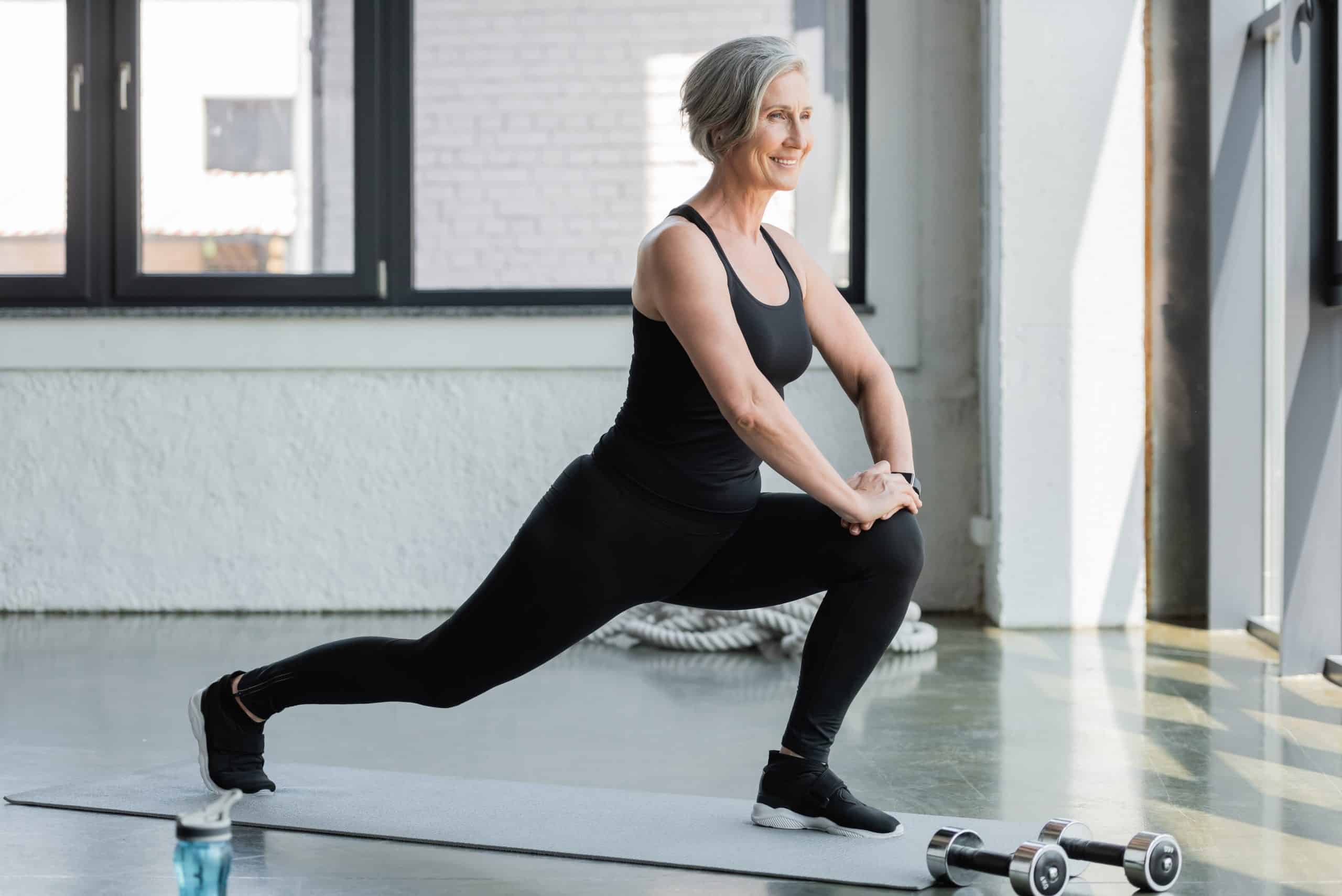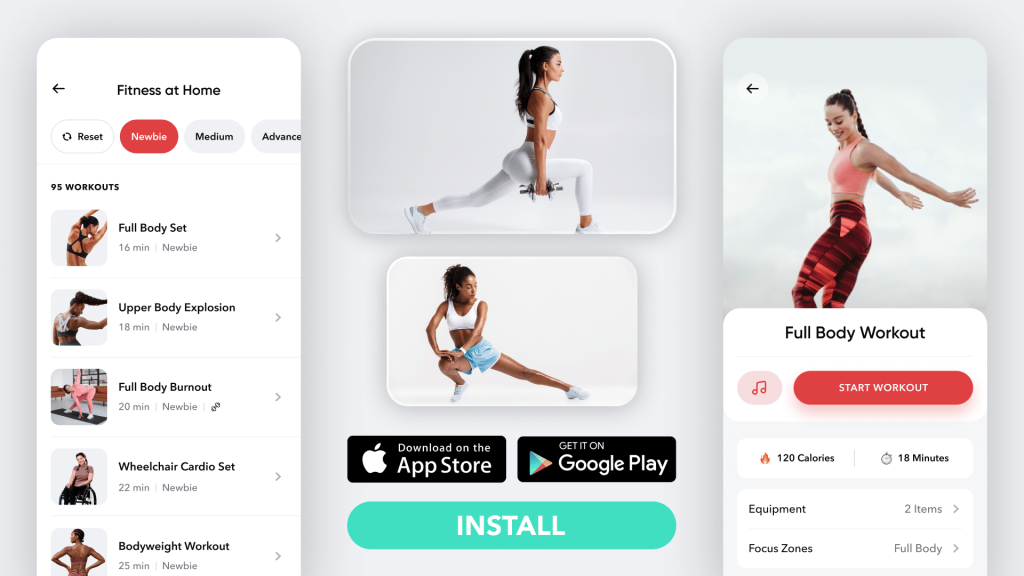Don’t you often feel like all eyes are on you when you do walking lunges around the myriad of equipment lying on a gym floor? Alternatively, you might have a bad knee and notice how lunges cause more discomfort. Either way, walking lunges alternative exercises can help. Don’t fret before the excitement hits. Let’s understand how lunges work before we get to the exciting exercise alternatives for walking lunges. Ultimately, you’ll find excellent replacement exercises for walking lunges if you have a bad knee or feel eyeballed in the gym.
Are Walking Lunges Good For You?
You’ll need to know the target muscles for walking lunges and a few more facts to determine whether they suit you. Walking lunges hurting your lousy knee doesn’t mean you can’t use alternatives. Every movement is unique.
Walking Lunges Target Muscles
First, let’s understand which muscles work with walking lunges. Researchers at the Seoul National University shared a study showing exact muscle activation during lunges (6).
They compared forward, walking, and reverse lunges to find the following activations:
- Biceps Femoris – The outer thigh hamstrings flex the knees and extend the hips (4).
- Erector Spinae – The muscles lie deep in the back, surrounding the spine and supporting spinal stability (7).
- Gluteus Maximus – The glutes control range of motion in the hips and knees (9).
- Rectus Abdominis – These muscles give you that incredible six-pack (20).
- Rectus Femoris – These muscles are a significant part of the quadriceps and are responsible for hip and knee movement (21).
- Semitendionisis – The superficial hamstrings aid knee flexes and rotations (23).
- Vastus Lateralis – The most significant muscle in your quads is responsible for hip and knee stability and flexibility (24).
- Vastus Medialis – Another quad muscle helping the hips and knees (25).
Read More: Lunges Muscles Worked, Variations, And Benefits
Important! Use Walking Lunge Alternatives With Bad Knees
Those muscle activations place immense pressure on your knee and hip joints. On the other hand, you work brilliant muscle groups to improve hip and knee mobility and strength. However, you can also overwork superficial and weaker muscles.
Research scientist James Ashton-Miller at the University of Michigan doesn’t recommend overusing weaker muscles (22). He doesn’t focus on the specific muscles mentioned above. However, he explains how too much load on weak muscles causes shrinkage.
Johns Hopkins Medicine already explains how damaged muscles or tendons commonly result in knee pain (18). You’ll work sensitive muscles already strained by the most common reasons for having knee pain. Not all exercises place as much force on the knee.
Researchers at California State University found that lunge movements caused improper mechanical force (2). It means the overlap of muscle fibers around your knee isn’t good. So, you struggle to exert pressure against the mechanical force, causing excess resistance.
Greater force doesn’t always equal better workouts, especially if you have bad knees. Johns Hopkins Medicine explains that tendonitis is another common problem (18). Jumper’s knee causes too much inflammation of your knee tendons when you experience too much force.
Finally, researchers published interesting results in the Journal of Orthopedic and Sports Physical Therapy (17). Lunges had a greater shear force than squats. It means your shin bone stops moving while your femur continues trying to push forward.
Shear force is negative in walking lunges, so you can’t use it with a bad knee. Fortunately, many alternatives can help you and some alternative variations can lower the impact. However, it is important to speak to your physician about knee pain before using walking or variation lunges.
The Benefits Of Walking Lunges For Those Who Can Do Them
Walking lunges aren’t an enemy. You’ll understand why when you see the benefits. Dumbbells can improve stability in non-athletic men. Scientists at Ningbo University studied the mechanics of lunge movements on novice athletes (15).
Walking lunges improve joint stability and strength, even in men who don’t exercise. However, the researchers suggest adding dumbbells for beginners. The Federal University of Santa Catarina’s researchers also proved walking lunges are better than static lunges (16).
It depends on whether you have knee pain or want to strengthen these joints. WebMD recommends walking lunges to stabilize knee and hip joints if no injuries exist (12). Also, people who can do walking lunges strengthen glute muscles and improve flexibility.
If you’ve mustered up the courage to crush your weight loss goal, let Betterme take the sting out of this demanding process. Our app will help you restructure your habits, remold your life and crank up your fitness results!
Top 3 Variation Alternatives To Walking Lunges For Weak Knees
Walking lunges aren’t always dull. How can you use variations safe enough for bad knees? Please speak to a physician first, or stop if the pain hits, but these alternatives are gentler on your joints and muscles.
Reverse Lunges Alternative For Bad Knees
Researchers at Seoul National University compared reversed lunges to walking lunges (6). They found that a reverse lunge’s maximum knee force was less than half of a walking lunge.
Use reverse lunges as a variation with a bad knee by following these steps:
- Stand with your feet even next to each other.
- Brace your core as you step back with one leg.
- Allow your body to drop gently as your leg moves back.
- Hold your bottom position for 5 seconds before returning your leg.
- Repeat 10 reps on each leg.
Walking Dumbbell Lunges Alternative For Bad Knees
Scientists at Ningbo University found that adding dumbbells to walking or traditional lunges improves stability (15). It can lower the impact on your knees. That’s all you need to safely do a variation that won’t send you cringing with pain.
Follow these steps to do them:
- Grab 2 dumbbells to stabilize your core while doing a reverse lunge.
- As you move one leg back, slowly bend your chest toward your knee.
- Lower the dumbbells to the floor on either side and hold for 5 seconds.
- Repeat 10 reps on each side.
Barbell Walking Lunges Alternative For Poor Knees
Ningbo University’s researchers also suggest using barbells to stabilize yourself better during lunge movements (15). It stabilizes your center and core enough to reduce impact and force on your joints.
Follow these instructions to use a barbell and landmine:
- Attach your barbell to your gym’s landmine for added stability.
- Hold the other barbell end in your hand.
- Brace your core before stepping back with the same leg on the barbell side.
- Wait 5 seconds at the bottom before coming back.
- Do 10 reps on each side.
Top Walking Lunges Alternative Exercise Options For Anyone
Variations can still place strain on your knees. You may opt for alternative exercises to lower the impact. Let’s see how these exercises are safe for bad knees.
Barbell Bench Squats
Bench squats work because you aren’t lowering yourself further than the bench. You can’t harm your knees or feel pain if the bench is high enough. WebMD confirms that the barbell adds resistance to an upper-body workout (3).
Do the barbell bench squat like this:
- Stand with your spine erect as you raise a barbell in line with your chest.
- Spread your feet apart until they align with your shoulders.
- Inhale as you slowly drop down while keeping your back as erect as possible.
- Your knees won’t extend over your toes before you sit on the bench.
- Straighten your spine while you rise, and don’t make sudden movements.
Bridge Pose
WebMD suggests a yoga pose to strengthen the glutes, hamstrings, and quads (11). Meanwhile, this low-impact stretch won’t weaken your knees with pain or discomfort. Yoga is low-impact resistance training safe enough for injured muscles.
Here’s how you do it:
- Lie on a comfortable but firm surface.
- Flatten your feet against the floor to align with your shoulder’s width.
- Support your body by placing your palms flat against the floor.
- Keep your knees bent in the same position as you gently raise your hips to the sky.
- Your shoulders remain against the floor.
- Breathe evenly and deeply as you hold the position for a minute.
- Drop slowly as you exhale, and repeat 10 times.
Read More: Lunge Variations: Shake Up Your Lower-Body Routine Like A Pro
Bulgarian Split Squat
Researchers at Georgia Southern University compared various squats to determine their impact on knee joints (5). The Bulgarian split squat had a significantly lower impact. The movements and balance reduce the shearing force on your knee.
Follow these instructions:
- Add a dumbbell in each hand while you rest one foot face-down on a bench.
- Step out with your grounded foot to ensure your knee doesn’t go over your toes.
- Gently squat down while keeping the dumbbells straight.
- Complete 10 reps per side.
Goblet Squat
Squats are brilliant alternatives. Medicine Net recommends straightening your torso to lower the knee impact (26). Goblet squats are also low-impact on your back muscles. Meanwhile, you can add a single dumbbell to help straighten your spine.
Use and follow these instructions:
- Hold your dumbbell vertically with both hands under the weight.
- Bring it to your chest, keeping it there throughout the movements.
- Inhale as you slowly squat down while keeping your torso erect.
- Don’t allow your butt to go lower than your knees or extend past your toes.
- Keep your spine upright as you rise and repeat 15 times.
Single-Leg Press
WebMD suggests leg presses as a safe exercise for painful knees (8). Without extending your knee over your shin or toes, you have no sudden shear force. So, it reduces the impact on your knees significantly.
Follow these steps to practice a single-leg press:
- Lie with your spine erect on a leg-press machine.
- Place one foot flat against the middle of the machine’s plate.
- Use your bottom heel to slowly press your leg forward.
- Bring your leg back and repeat, but don’t press until it hurts.
Single-Leg Romanian Deadlifts
Researchers at Western Michigan University compared standard and Romanian deadlifts (1). Traditional deadlifts place a greater force on the knees than Romanian deadlifts. However, the technique ensures safety.
So, follow these instructions to be safe:
- Keep your feet next to each other as you shift your weight to one leg.
- Start with two dumbbells on either side as you straighten your spine.
- Keep the back erect as you slowly bend forward.
- Your knee must only bend 2 inches as you near the ground.
- Slowly extend one leg backward to find your perfect balance.
- Hold the position for 5 seconds before bringing the leg back.
- Embrace the core muscles to raise your straight torso slowly.
- Shift your main weight to the opposite leg and repeat.
Reasons why BetterMe is a safe bet: a wide range of calorie-blasting workouts, finger-licking recipes, 24/7 support, challenges that’ll keep you on your best game, and that just scratches the surface! Start using our app and watch the magic happen.
Sled-Drag
The Auckland University of Technology researchers examined sled pulling and pushing in athletic speed performances (19). No evidence suggests shear force, but the load on the targeted low-limb muscles is excellent for strength and endurance training.
Use these instructions to safely execute them:
- Start with a comfortable weight on the sled and use a harness to secure yourself.
- Face the sled as you slowly step back while keeping your spine straight.
- You may lean back gently to increase the resistance but stay erect as you tilt.
- Step back as often as you can manage with the sled’s weight.
Bonus: Simple Walking Lunge Alternatives For Painful Toes And Knees
It doesn’t matter why you have toe pain. It can affect which exercises you use as alternatives for knee problems. You don’t want to rest your painful toe against a bench. So, let’s see which options work for both issues.
Step-Ups
WebMD recommends step-ups as an ideal exercise to strengthen lower body muscles without injuring your knees (8). It may even improve knee pain and reduce inflammation. Meanwhile, it’s a fun workout you can do anywhere, even at home.
Follow these instructions:
- Stand with both feet flat on a bench or step.
- Slowly bend your knee while moving one foot toward the ground.
- Keep your pelvis straight as you lower one leg.
- Bring it back before repeating it on the other side.
- Complete 10 reps on each side.
Kettlebell Step-Ups
Kettlebells are another alternative to add stable weight to keep pressure off your knees. Very Well Fit recommends adding kettlebells as a low-impact resistance workout (13). It’s safe for your toes as long as you don’t drop it.
Follow these instructions for safety:
- Start with a kettlebell in each hand as you embrace your core and straighten your spine.
- Keep your body straight as one knee bends to climb a stair.
- Put your foot flat before bringing the second foot to the stair.
- Maintain an erect body as you reverse your movements one by one.
- Keep climbing stairs up and down.
Wall Squats
The Arthritis Foundation recommends adding a wall to stabilize your squats for low-impact exercises on your knees (14). Meanwhile, you have no impact or pressure on your toes.
So, follow the instructions to ensure you’re squatting correctly against the wall:
- Place your back flush against a wall.
- Separate your feet shoulder-width apart as you keep your legs straight.
- Your knees must line up with your heels and not in front of the toes.
- Gently squat down as you inhale and move back up as you exhale.
- Your butt must not go lower than your knees, and stop if you feel pain.
- Tighten your core and abdomen muscles as you rise.
FAQs
Are Walking Lunges Effective?
Scientists at the Seoul National University examined the muscle activations during different lunge movements (6). For a lower-body workout, walking lunges activate the glutes, hamstrings, erector spinae, quadriceps, and abdomen muscle groups.
Are Walking Lunges Better Than Stationary Lunges?
The Federal University of Santa Catarina researchers compared walking and static lunges (16). The trunk position during the lunge movement makes a difference. So, walking lunges improve lower lumbar support and glute activation more than static lunges, and are surely better.
Do Walking Lunges Work The Glutes?
Researchers at Seoul National University confirmed in a study that walking lunges work the glutes (6). The mean glute activation was the same in walking and forward lunges. However, reverse lunges had a higher mean glute activation under the same conditions.
Are Walking Lunges Better Than Squats?
Researchers at California State University examined various studies surrounding muscle activation during lunges (2). Ultimately, they found an interesting answer to this question. The unilateral lunge movements increase balance and coordination more than lateral squats.
In contrast, the same researchers found that lunges resulted in bad mechanical force around the knee (2). The answer depends on whether you have a bad knee. However, you can use lunges to improve your lower limb balance and coordination if you don’t have knee problems.
The Bottom Line
It doesn’t matter if you have a bad knee, a painful toe, or are tired of walking movements over too much gym equipment. You have an alternative that works in your favor. Some variations are exciting but you can try those other exercises as well.
DISCLAIMER:
This article is intended for general informational purposes only and does not serve to address individual circumstances. It is not a substitute for professional advice or help and should not be relied on for making any kind of decision-making. Any action taken as a direct or indirect result of the information in this article is entirely at your own risk and is your sole responsibility.
BetterMe, its content staff, and its medical advisors accept no responsibility for inaccuracies, errors, misstatements, inconsistencies, or omissions and specifically disclaim any liability, loss or risk, personal, professional or otherwise, which may be incurred as a consequence, directly or indirectly, of the use and/or application of any content.
You should always seek the advice of your physician or other qualified health provider with any questions you may have regarding a medical condition or your specific situation. Never disregard professional medical advice or delay seeking it because of BetterMe content. If you suspect or think you may have a medical emergency, call your doctor.
SOURCES:
- An Electromyographic and Kinetic Comparison of Conventional and Romanian Deadlifts (2018, nih.gov)
- Balance and Lower Limb Muscle Activation Between In-Line and Traditional Lunge Exercises (2018, nih.gov)
- Barbell Row: Muscles Worked, Benefits, and More (2022, webmd.com)
- Biceps Femoris (n.d., physio-pedia.com)
- Biomechanical Differences Between the Bulgarian Split Squat and Back Squat (2021, nih.gov)
- Comparative Analysis of Lunge Techniques: Forward, Reverse, Walking Lunge (2016, semanticscholar.org)
- Erector Spinae (n.d., physio-pedia.com)
- Exercises to Help Knee Pain in Pictures (n.d., webmd.com)
- Gluteus Maximus (n.d., physio-pedia.com)
- How to Do a Barbell Row (2022, webmd.com)
- How to Do a Bridge Yoga Pose (2022, webmd.com)
- How to Do Walking Lunges (2022, webmd.com)
- How to Do Weighted Step-Ups: Proper Form, Variations, and Common Mistakes (2022, verywellfit.com)
- How to Squat Correctly (n.d., arthritis.org)
- Influence of Different Load Conditions on Lower Extremity Biomechanics During the Lunge Squat in Novice Men (2022, nih.gov)
- Influence of Trunk Position During Three Lunge Exercises on Muscular Activation in Trained Women (2021, nih.gov)
- Knee Joint Loading in Healthy Adults During Functional Exercises: Implications for Rehabilitation Guidelines (2018, nih.gov)
- Knee Pain and Problems| Johns Hopkins Medicine (n.d., hopkinsmedicine.org)
- (PDF) Sled Pushing and Pulling to Enhance Speed Capability (2019, researchgate.net)
- Rectus Abdominis (n.d., physio-pedia.com)
- Rectus Femoris (n.d., physio-pedia.com)
- Response of Muscle and Tendon to Injury and Overuse (n.d., nih.gov)
- Semitendinosus (n.d., physio-pedia.com)
- Vastus Lateralis (n.d., physio-pedia.com)
- Vastus Medialis (n.d., physio-pedia.com)
- What Does a Goblet Squat Work? (n.d., medicinenet.com)












